If you want to know about the Permeable concrete or Islamic architecture or staircase design, please click the link.
Introduction
Baroque architecture is a style of architecture that emerged in Europe in the late 16th century and reached its peak in the 17th and early 18th centuries. It is characterized by its elaborate ornamentation, dramatic use of light and shadow, grandeur, and the illusion of movement and energy.

The origins of Baroque architecture can be traced back to the Counter-Reformation period, which was a response by the Catholic Church to the Protestant Reformation.
The Catholic Church sought to reassert its dominance and authority through a grand display of religious art and architecture. Baroque architecture was thus closely tied to the Catholic Church and was often used to convey religious themes and messages.
Baroque architecture was also influenced by the scientific and artistic developments of the time, such as the discovery of perspective and the use of light and shadow in art. Baroque architects sought to create a sense of theatricality and illusion through the use of curved lines, exaggerated shapes, and trompe l’oeil effects.
The Baroque style spread throughout Europe and eventually to the Americas through colonialism. It was used in the construction of grand palaces, churches, and public buildings, and was favored by royalty and the wealthy elite.
Today, Baroque architecture’s is recognized as a significant artistic and cultural movement that reflects the political, social, and religious developments of its time.
1) Characteristics of Baroque Architecture
Baroque architecture is characterized by its dramatic use of light and shadow, curves, ornate decoration, grandeur, and emphasis on movement and energy. Here are some of the key characteristics of Baroque architecture:
Dramatic use of light and shadow:
Baroque architects used light to create dramatic effects, such as the illusion of depth, contrast, and drama. They achieved this by using strong contrasts between light and dark, creating deep shadows and bright highlights.
This technique, known as chiaroscuro, was often used to highlight the ornate decoration and sculptures on Baroque buildings.
Curves, ornate decoration, and grandeur:
Baroque architecture is known for its elaborate ornamentation, which often features curves, floral motifs, and scrollwork. This decoration is typically symmetrical and arranged in a grand, theatrical manner that emphasizes the building’s size and importance.
Baroque buildings often have a sense of movement and dynamism, with curving forms and sweeping lines that create a sense of flow and energy.
Use of illusion and trompe l’oeil:
Baroque architects often used trompe l’oeil, a technique that creates the illusion of three-dimensional space on a flat surface, to create dramatic effects.
For example, they might paint a flat ceiling to look like a domed sky, or use sculpture and ornamentation to create the illusion of depth and movement. This technique added to the theatricality and grandeur of Baroque buildings.
Emphasis on movement and energy:
Baroque architects sought to create a sense of motion and energy in their buildings, often using sweeping curves, dynamic shapes, and ornate decoration to create a sense of drama and excitement.
This style was intended to capture the viewer’s attention and create a sense of awe and wonder, reflecting the grandeur and power of the institutions and individuals that commissioned these buildings.
Overall, Baroque architecture’s is a style that is characterized by its theatricality, ornate decoration, and grandeur.
Its dramatic use of light and shadow, curving forms, and illusionistic effects make it a visually striking and impressive style that continues to inspire architects and artists today.
2) Examples of Baroque architecture
Here are some examples of buildings that feature Baroque architecture:
St. Peter’s Basilica, Vatican City
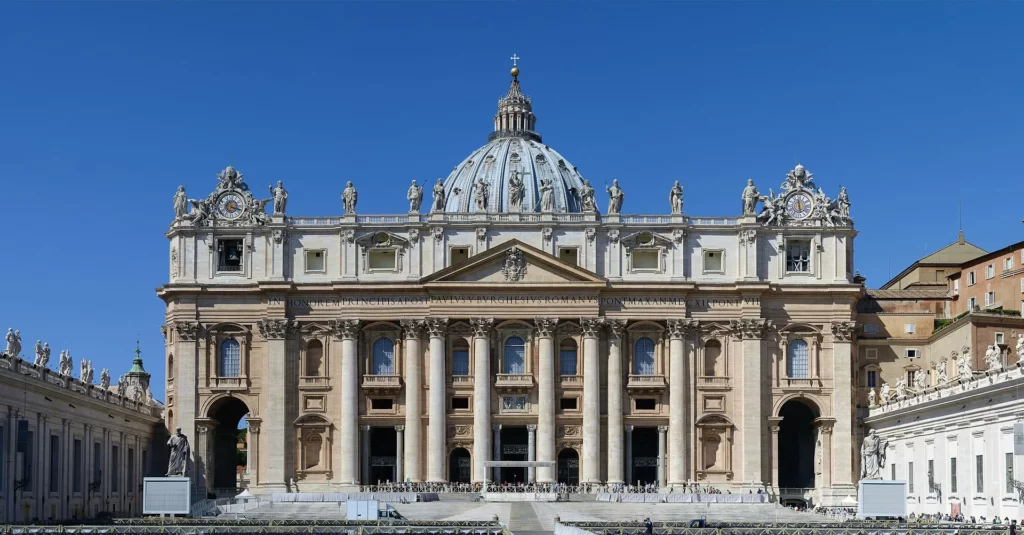
- Designed by Gian Lorenzo Bernini and Carlo Maderno in the 17th century
- Features a grand dome, ornate façade, and extensive use of marble and sculpture
- One of the most iconic examples of Baroque architecture and a symbol of the Catholic Church
Palace of Versailles, France

- Commissioned by Louis XIV in the 17th century as a royal residence
- Features a grand symmetrical façade, ornate interiors, and extensive gardens
- Exemplifies the grandeur and excess of Baroque architecture and the French monarchy
Zwinger Palace, Germany

- Built in the 18th century as a royal palace in Dresden
- Features a Baroque façade, elaborate gardens, and collections of art and porcelain
- A significant example of Baroque architecture in Germany and a popular tourist attraction
San Carlo alle Quattro Fontane, Italy

- Designed by Francesco Borromini in the 17th century
- Features an undulating façade, innovative use of curves and light, and sculptural decoration
- An important example of Baroque architecture in Rome and an influence on later architects
Church of Santo Domingo, Peru

- Built in the 18th century in Lima as part of the Baroque architecture of Latin America
- Features a colorful façade, ornate interior with gold leaf and sculpture, and use of indigenous and African influences
- Represents the syncretism of Baroque architecture with colonialism and cultural exchange in the Americas
These are just a few examples of the diverse range of buildings that showcase the characteristics and influences of Baroque architecture.
3) Baroque Architecture in Europe
Baroque architecture originated in Rome, Italy, in the early 17th century and spread throughout Europe, becoming one of the most popular architectural styles of the 17th and 18th centuries.
Here are some examples of Baroque architecture in Europe:
- Italy: Some of the most famous examples of Baroque architecture in Italy include the Church of the Gesù and the Trevi Fountain in Rome, the Palazzo Barberini in Rome, and the Basilica di Superga in Turin.

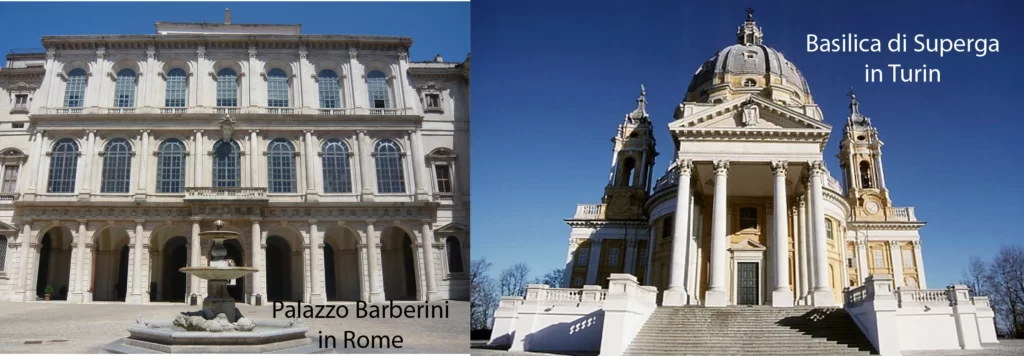
- Spain: In Spain, the Royal Palace of Madrid and the Cathedral of Santiago de Compostela are prime examples of Baroque architecture.
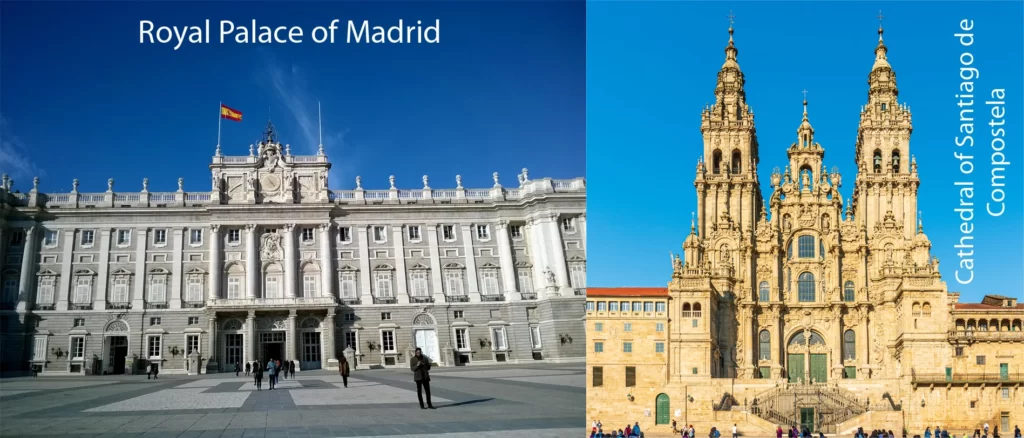
- France: The Palace of Versailles is perhaps the most famous example of Baroque architecture in France, along with the Church of Saint-Paul-Saint-Louis in Paris.

- Germany: The Würzburg Residence in Würzburg, Germany, is one of the most famous examples of Baroque architecture in the country, along with the Augustusburg and Falkenlust Palaces in Brühl.

Overall, Baroque architecture’s in Europe is characterized by its ornate decoration, dramatic use of light and shadow, and grandeur.
These buildings were often commissioned by the Catholic Church or royalty and were intended to impress and awe their viewers.
Today, many of these buildings are popular tourist attractions and serve as important examples of the Baroque style in architecture.
Key architects and artists of the Baroque period
- Gian Lorenzo Bernini: an Italian sculptor and architect, known for his work on St. Peter’s Basilica and the Fountain of the Four Rivers in Rome.
- Francesco Borromini: an Italian architect, known for his work on the Church of San Carlo alle Quattro Fontane and the Palazzo Barberini in Rome.
- Peter Paul Rubens: a Flemish artist, known for his Baroque paintings of religious and mythological subjects.
- Diego Velázquez: a Spanish painter, known for his portraits and Baroque depictions of historical events.
4) Baroque Architecture in the Americas
Baroque architecture was also widespread in the Americas, particularly in areas that were colonized by European powers during the 16th and 17th centuries. Here are some examples of Baroque architecture in the Americas:
- Mexico: The Metropolitan Cathedral in Mexico City is one of the most famous examples of Baroque architecture in Mexico, along with the churches of Santo Domingo and La Compañía in Oaxaca.

- Peru: The Church of San Francisco in Lima, Peru, is a prime example of Baroque architecture in the country, along with the Church of the Society of Jesus in Cusco.
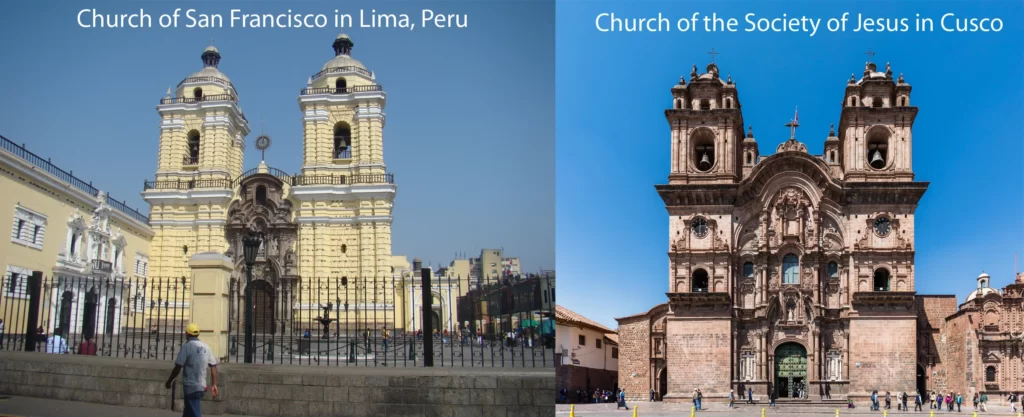
- Brazil: The Church of São Francisco de Assis in Ouro Preto, Brazil, is one of the most famous examples of Baroque architecture in the country.

- Cuba: The Cathedral of Havana is a prime example of Baroque architecture in Cuba, along with the Church of Santa Clara in Trinidad.
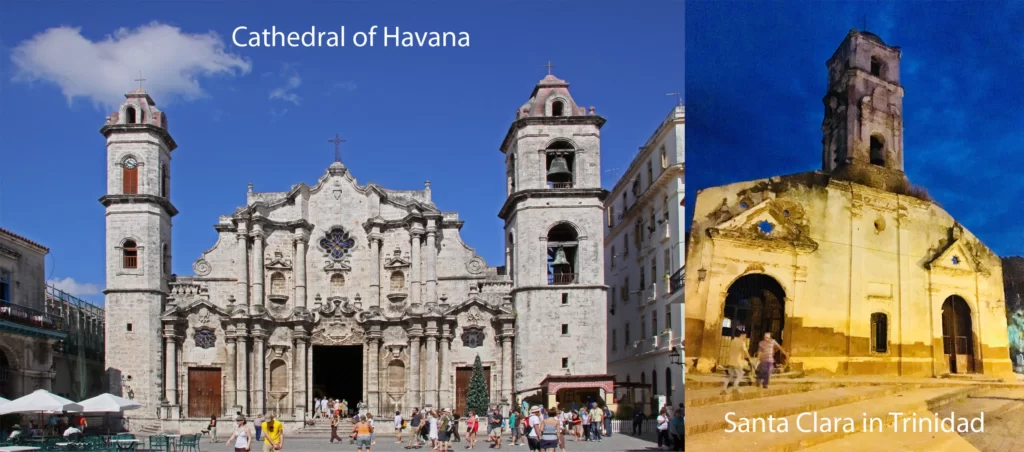
In the Americas, Baroque architecture’s often incorporated local materials and techniques, as well as elements from indigenous cultures.
The buildings were often used to impress and assert the power of European colonial powers, particularly the Catholic Church.
Today, these buildings serve as important examples of the Baroque style in architecture and as a reminder of the complex history of colonialism in the Americas.
5) Baroque Architecture and Natural Elements
Baroque Architecture makes significant use of natural elements, such as water and light, to create dramatic effects and to enhance the overall beauty of the building.
The style’s emphasis on light and shadow is often used to create a sense of depth and dimensionality, while the use of water features, such as fountains and reflecting pools, can add a sense of motion and life to the building’s design.
The relationship between Baroque Architecture and nature is complex. While Baroque Architecture is known for its ornate decoration and grandiose forms, it is also deeply connected to the natural world.
The use of natural elements, such as water and light, is just one example of the way in which Baroque architects sought to create buildings that were in harmony with their surroundings.
Many Baroque buildings were designed to incorporate natural features, such as gardens and courtyards, that were used to create a sense of tranquility and serenity.
Examples of Baroque Architecture that incorporate natural elements include the Palace of Versailles in France, which features elaborate gardens, fountains, and reflecting pools that are integrated into the building’s design.
Another example is the Trevi Fountain in Rome, which is one of the most famous Baroque fountains in the world. The fountain features a dramatic sculptural composition that is surrounded by water, creating a sense of motion and life.
Finally, the Sanctuary of Loyola in Spain is another example of Baroque Architecture that incorporates natural elements. The building is situated in a natural landscape and features a series of gardens and fountains that create a sense of tranquility and harmony with the natural surroundings.
6) Baroque Architecture’s and Art
Baroque architecture and art are closely related, as they emerged during the same period and share many characteristics. Here are some ways in which Baroque architecture’s and art are connected:
- Use of ornamentation: Both Baroque architecture and art feature highly decorative elements, such as intricate carvings, reliefs, and sculptures. These decorations were intended to create a sense of drama and awe in the viewer.
- Emphasis on light and shadow: Baroque art and architecture both utilize chiaroscuro, the use of contrasting light and shadow, to create a sense of depth and drama.
- Allegory and symbolism: Baroque art and architecture often feature allegorical and symbolic elements, such as figures and motifs that represent virtues or abstract concepts.
- Grandeur and scale: Baroque architecture and art both emphasize grandeur and scale, with large, imposing buildings and paintings that create a sense of awe in the viewer.
Overall, Baroque art and architecture were closely connected during the 17th and 18th centuries, with artists and architects often collaborating on large-scale projects for churches, palaces, and other public buildings. Today, both Baroque art and architecture continue to be celebrated for their intricate beauty and their influence on subsequent artistic movements.
7) Baroque Architecture’s and Urban Planning
Baroque architecture’s had a significant impact on urban planning during the 17th and 18th centuries. Here are some ways in which Baroque architecture influenced urban planning:
- Monumentality: Baroque architecture’s often emphasized monumentality, with large buildings and public spaces intended to convey a sense of power and authority. This led to the creation of grand boulevards, large public squares, and monumental buildings in many European cities.
- Emphasis on the street: Baroque urban planning emphasized the street as a central feature of the city, with buildings oriented to face the street and public spaces located along the street frontage. This created a sense of continuity and coherence in the urban fabric.
- Use of axial planning: Baroque urban planning often utilized axial planning, with streets and public spaces arranged in a symmetrical, geometric pattern. This created a sense of order and harmony in the city.
- Integration of landscape design: Baroque urban planning often integrated landscape design into the city, with parks, gardens, and fountains used to enhance the urban environment and create a sense of beauty and tranquility.
Overall, Baroque urban planning had a significant impact on the development of European cities during the 17th and 18th centuries, with many of the principles and strategies used in Baroque planning continuing to influence urban design today.
8) Legacy of Baroque Architecture
Baroque Architecture has had a significant influence on later architectural styles. The style’s emphasis on ornate decoration, dynamic forms, and dramatic effects can be seen in later styles such as Rococo, Neoclassicism, and Art Nouveau.
Many architects have drawn inspiration from Baroque Architecture, incorporating elements such as curved lines, ornate details, and dramatic lighting effects into their designs.
Baroque Architecture is considered to be one of the most important styles in the history of architecture. The style emerged in the 17th century in response to the social and political changes of the time, and reflected the growing power and wealth of the ruling classes.
Baroque Architecture was used to create buildings that were not only functional but also visually impressive, and that communicated a sense of power and prestige.
Examples of Baroque-inspired architecture in modern times can be found all over the world. Many contemporary architects have drawn inspiration from Baroque Architecture, incorporating elements such as dramatic lighting, ornate decoration, and dynamic forms into their designs.
One example of Baroque-inspired architecture is the Burj Al Arab hotel in Dubai, which features a grandiose facade with sweeping lines and ornate details. Another example is the Palazzo Lombardia in Milan, which features a striking facade with intricate details and bold lines.
9) Conclusion
In conclusion, Baroque Architecture is a highly ornamental and dramatic style that emerged in Europe during the 17th century. It is characterized by its grandiose forms, use of light and shadow, dynamic and curved lines, and extensive ornamentation and decoration. Baroque Architecture often incorporated natural elements, such as water and light, into its designs to create dramatic effects and to enhance the beauty of the building.
- Baroque architecture’s is characterized by its dramatic use of light and shadow, ornate decoration, and emphasis on movement and energy.
- The Baroque period saw the emergence of many important architects and artists, including Bernini, Borromini, and Rubens.
- Baroque architecture’s was heavily influenced by the Catholic Church and European royalty, reflecting the political and cultural values of the time.
- Baroque architecture’s had a significant impact on urban design, with many cities incorporating grand public spaces and ornate facades into their layouts.
- Baroque architecture’s has had a lasting legacy, with many contemporary buildings and designs drawing inspiration from Baroque principles.
Baroque architecture’s in history and culture
- Baroque architecture’s represents a significant chapter in the history of Western art and architecture, reflecting the political, cultural, and intellectual trends of the Baroque era.
- Baroque architecture’s has left a lasting legacy, shaping the layout and function of many cities and inspiring generations of architects and designers.
Preserving and celebrating Baroque architecture’s
- It is important to preserve and celebrate Baroque architecture as a vital part of our cultural heritage and identity.
- This can be done through efforts to restore and maintain Baroque buildings and public spaces, as well as through educational initiatives aimed at promoting an understanding and appreciation of Baroque architecture.
- By preserving and celebrating Baroque architecture’s, we can ensure that this important cultural legacy continues to inspire and enrich our lives.
Overall, Baroque Architecture is an important part of the history of architecture, and its legacy can be seen in many buildings and structures around the world. Its influence can also be seen in the work of contemporary architects who continue to incorporate Baroque elements into their designs.